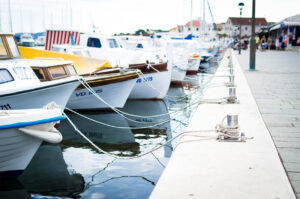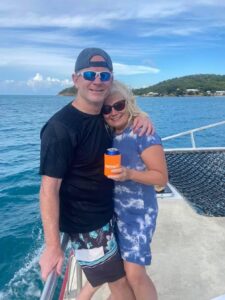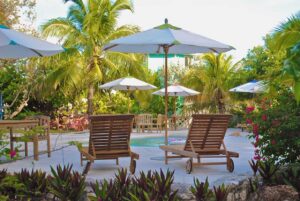If you’ve ever sipped a beverage while sitting in a waterside restaurant then you’ve probably witnessed some awesome docking … sometimes in a can’t-look-away-from-the-wreck awesome. To avoid being the star of a Youtube video you will want to use these docking tricks and tips, many of which only require a bit of practice.
Docking Neophytes
As with anything worth doing, a little bit of effort goes a long way, and practice will enhance that effort! For the first few times you take out your new boat try to do it when the marina is not busy and few boats are underway. A weekday morning when the tide is slack creates the best learning environment. Don’t forget to tell the marina staff that you will be in and out of your slip and won’t require any help. You will feel less pressure if you have no audience as you practice your close quarters maneuvering.
If you are fortunate enough to work with a training captain, start your very first time at the helm well after the boat is out of its slip. Discovering what it takes to slow, stop and actually reverse your boat combined with how it is affected by tide, current and wind are the first steps to successful docking. Performing these skills while away from the dock allows a new helmsman to build docking confidence without concern for the occasional oops! Soon these skills will become instinctive with diligent practice.
Marina Approach
Whether this will be your home port or your temporary tie-up for a weekend adventure, there’s a first time in every marina. Everything looks different from the water so try to learn as much as you can before coming in to your slip. One easy way to explore your options is to stop at the fuel dock first. Fill your fuel tanks or pump out the holding tank then take a walk over to your assigned slip. Scan the surrounding docks for protruding bow pulpits or swim platforms that may require extra maneuvering. Is the power pedestal positioned that you must go bow or stern in? Will the starboard or port side be against the finger pier? Is the pier floating or fixed, as each calls for different fender requirements?
For those boaters in tidal areas, be sure to see from which direction and how fast the current is moving. You may need to compensate and overshoot your slip, allowing the dominant force of wind or current to help your maneuvering. Don’t fight the force. Let the force be with you.
Tools of the Trade
While every helmsman should become adept at maneuvering with engines only, it’s not cheating to use the tools you have at your disposal. Bow and stern thrusters are a bonus when you must slide right into a side-tie slip, but it’s important to know their limitations. Get comfortable with how much power is available, either battery- or generator-assisted hydraulic thruster.
Remember that pilings are your friend, unless they are cement! It’s OK to lay your boat’s rub rail against a sturdy wood piling, sometimes using it as a fulcrum when the wind or tide challenges your maneuvers. And for good measure, have a walking fender — one that’s loose and easy to grab — ready for your mate to strategically place when contact is unavoidable. Boat poles can make the difference between getting that line over the piling or launching a dinghy to make it happen. One pole is essential, two is preferred, and three assures you will have a boat pole available when the others go in the drink! A floating boat pole is wonderful, but you still need a second pole to retrieve the first.
Dock lines with large loops are terrific for placing over pilings without choking them. A choked line is difficult to remove from a piling and may need to be left behind. Either splice in a large enough loop or learn to properly tie a bowline, which will create a loop of the size you desire. Many boaters purchase prepackaged cut and spliced dock lines. That’s usually fine for smaller boats. Be sure to have long enough lines to spring forward and aft to deal with tidal changes once you’ve landed safely and are permanently securing your lines.
Breast vs Spring Line
This is always a great topic for a dockside discussion, but our first docking line is almost always a breast line. ?is docking line is attached to the centermost cleat on your boat and unlike the spring line, the breast line is secured at the dock perpendicular to the boat and as short as possible.This is a temporary line that prevents the boat from blowing off the dock or moving too far forward or aft. Once you have successfully landed, readjust this line to become a spring line.
With a bit of practice the breast line can often be secured to the dock without your mate ever leaving the boat. no jumping from the side deck and no dockside help needed! But if you do require help, $5 makes a nice thank you to the marina dockhands.
Crew Communications
Unless you are single handing, it is essential to keep your crew in the loop. Plan your docking strategy, then share the plan with your crew, agree to it and be prepared for changes. It helps if you walk in each other’s deck shoes and understand the responsibilities of each crew member but minimally you must find a way to communicate what is occurring — breast line is ON! When the line is secured or Secure stern line first! When the helmsman feels a change in the plan is required.
So how do you talk when the wind is howling or your boat is too big to hear each other clearly? Technology is a wonderful thing and options are plentiful. In addition to a two-way hailer there are head-set selections for every budget. Be sure you recognize the possibility of snagging wires and cumbersome battery packs so try before you buy when possible. After you become competent with each other’s roles then short, key words can help describe a multitude of situations. No need for long explanations to get the job done.
Docking is an art that can be refined with practice, or for some lucky boaters it is plain ole raw talent. Just remember that sometimes you watch the show and sometimes you are the show.





